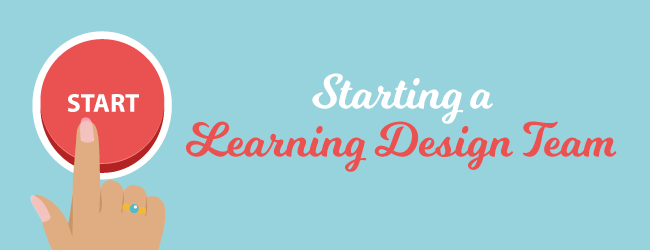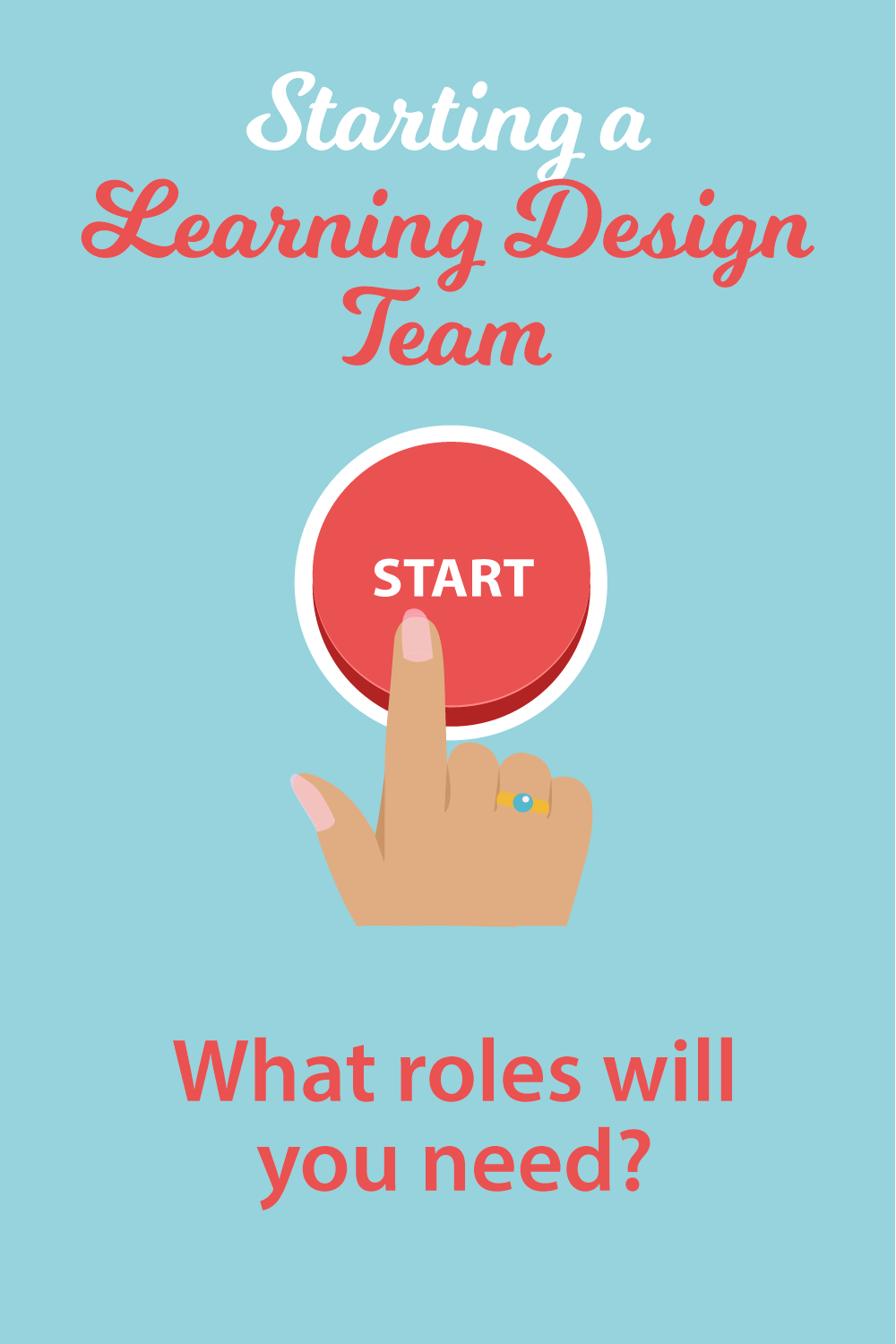
It may not be as easy as pressing a button, but with enough research and planning, your organization can build an instructional design team. You will need to define its purpose and understand the roles that are required for such a team. Ideally, you will consult with a knowledgeable professional to ensure you hire or develop people with the vision and skills needed to fulfill the roles I describe below.
The Vision
Why will your team need a vision for the future? Because they will need to meet the unprecedented changes in work culture and technological innovation that keep coming. As leaders recognize the importance of employee development, the Learning and Development team should elevate in importance. These are the people that can help organizations develop an employee-centered culture. A culture where learning and training are individualized and encouraged.
Start Small and Grow
If you think of learning as a journey and one that may require many types of experiences, then you can imagine the roles that might be needed in your learning and development team. Often, one person takes on many roles, particularly in smaller teams. It’s best to avoid the one-person team, as this leads to conflicting demands that will end up in burn-out and lower quality work. Consider growing a team that starts with at least two multifaceted people with complementary skills. Give them scheduled time to continue to learn and develop.
If you only need some roles part-time, consider using staff from other departments or contracting the work to freelancers. For example, a new team might need editing and testing work on a part-time basis so these roles could be outsourced.
Learning Design/Instructional Design Team Roles
Select a few roles below that makes sense for your organization. It is typical for multi-talented people to take on more than one role when a team is small. Keep in mind that an effective learning design team will focus on solving performance problems and will provide opportunities to develop the long-term capabilities of each employee.
- Project Manager Role: Oversees the scheduling and deliverables of project life cycles. Interfaces with internal clients and ensures the team has the information and resources it needs to get the job done. If working as a team lead, this person may help provide the business analysis to ensure that solutions match the business and organizational goals.
- *Learning Designer (a.k.a. Learning Experience Designer or Instructional Designer) Role: This is the most essential role on the team. The learning designer follows an instructional design process to analyze and design learning solutions based on context, cognitive psychology, and best practices. Writes manuals, workbooks, storyboards, scripts, and performance support tools. Identifies and may create the visuals and media for varied projects.
- User Experience Designer Role: Ensures that solutions are user-friendly, searchable, and provide easy access to information. May create the user interface.
- Community Manager Role: As leaders begin to understand the importance of learning in conversation with others, organizations will need community managers to facilitate discussion and sharing.
- Content Curator Role: Future-minded organizations will take advantage of the curator specialist. This person will identify, select and annotate existing assets in a specialty topic. See more about this role in The Power and Practice of Digital Curation.
- Facilitator and Trainer Roles: This role provides and supports learning opportunities in group settings.
- Editor Role: Proofreads and improves writing.
- Graphic Designer Role: Creates the user interface, graphics, and animations; designs the look and feel of courses, learning portals, mobile learning, and print materials with an eye toward clarity for learning and understanding.
- Media Specialist Role: Produces and edits audio and video.
- Developer Role: Uses authoring tools to assemble media elements into interactive courses. May need to design and develop websites, eLearning, mobile learning, augmented reality, and other technology-based solutions.
- Tester Role: Runs Quality Assurance checks by testing all products and ensuring they are as free from errors as possible. It is best if the developer does not do the testing.
Working with Subject Matter Experts (SMEs)
A common misunderstanding is that the learning design group must have expertise in the skill areas for which they design. In practice, instructional designers and other team members work with subject matter experts during the process of learning design. Also, learning experience designers may research the subject in place of or in addition to working with experts. See How to Brain Sync with a Subject Matter Expert for more on this.
Match Your Requirements to the Roles
Note that new teams should not attempt to fulfill all the roles listed above. First, identify your priority requirements based on the organization’s challenges. Seek multi-talented people who can fulfill one or two of your top priority roles. Don’t be afraid to start building a team, but do so slowly and allow your vision to evolve. This is an exciting field and an ideal time to build internal capabilities.


Hi Tara,
I do not have any templates for this but I do have some advice. If you do bring on an eLearning team, I would ensure that the new team as well as L&D are flexible and open to other solutions for learning in the workplace (including formal and informal learning). It’s important to assess the needs and context of each audience group. The closer you can integrate learning with work, the better. For example, if people are out in the field all day, job support in a mobile app might be the best solution. If someone is an expert in their field, they may only require content curation to continue learning. I’ll email you a link for a quick (free) consultation if you have questions.
Connie
Any examples or templates on benefits on adding an elearning team to current L&D team? We provide elearning creation but getting more and more requests. It’s time to suggest a dedicated team to do this. Any info would help.
Thanks,
Tara
Reema,
Look under eLearning 2.0. Maybe some of those articles will help you.
Connie
I am working with one E-learning environment at university. I need to know more about which features and innovations must do to e-learning department.
I need some ideas about new things for e-learning department.
Hi Aziz,
You can contact me if you’d like more information on my consulting services. Please use the form on the Contact Me page: https://theelearningcoach.com/contact/.
Best,
Connie
The article is very much informative. However, in order to setup e-Learning Department in a Training Division of Bank, I need a comprehensive organizational structure with specific role / responsibility along with Job Descriptions of the following:
Instructional Designer/Writer, Editor of the Course, Graphic Designer, Media Specialist, Authoring Tools Specialist and Checker/Quality assurer etc.
Your help / support in the matter would be highly appreciated.
Hi Sue,
I’m going to email you to find out exactly what you mean.
Connie
Hi Connie,
This is a great article. I love the way it outlines roles of team members while building an internal design team. Would you be able to share some light on what would be key factors to consider while establishing this team perhaps in the first 30 days ? keeping in mind that there are ID deadlines to meet along the way? any best practices ?
Good luck with that, Joe! Thanks for stopping by
Hi Connie,
Nice to find this article in my G search for “what are the roles of team members in an online learning project?” I have a newfound appreciation for why a team of people is needed for good eLearning development: I’m attempting to do it all on the final project for my Masters right now. Whew!
-Joseph Roberson
Hi Fatin,
I sent you an email but I will state this again in case anyone else is interested:
There is no one rule, but in my experience, usually the instructional designer writes the storyboard because he or she can come up with engaging and appropriate learning strategies. The storyboard will be based on agreed-upon learning objectives, of course.
But you can get help from the SME along the way. You might ask the SME (subject matter expert) for some case studies that meet your criteria. For example, suppose you have a course on what equipment to wear when going into the room of someone with tuberculosis. You might ask the SME to give you a case with a medical record for a patient who is highly infectious. Then you can write a scenario in the storyboard, using the SME’s knowledge.
Or for a course teaching project management, you might ask the SME, “What are the three top mistakes a new project manager makes?” Then in your scenario, the new project manager would make those mistakes. So in that way, it is a collaborative effort, but because most SMEs don’t know the science of learning, nor can always visualize a course, the instructional designer can be the starting point for the storyboard.
The only way I have seen it be different, is when the SME is experienced in learning design and then they can write the first draft of the storyboard and you would correct and revise it.
Best,
Connie
Thanks alot for you.
1- Does the one who have a content can also write the storyboard for that content?
2- Should the storyboard writer be with the same specialty of the person who have the content?
As, for a medical content, we should have one with medical background to write its storyboard?
Laura,
I’m sorry but I have not seen a discussion on that tipping point. Fascinating question though. I do have an article about Starting an eLearning Development Team though, in case you’re interested. Perhaps a reader will know of an article specific to your question. Also, I suggest you post it on one of the LinkedIn ID groups.
Best,
Connie
Do you have any guidelines or recommended resources that discuss at what point companies typically start to build in-house eLearning teams? I will certainly do my own cost-benefit analyses, but curious to hear thoughts from others about the tipping point.
People might use these words as synonyms. One could argue that content developers create content for an audience to view or read, but that instructional designers create content for an audience to comprehend, retain and transfer to new situations.
What is the difference between a content developer and instructional designer?